13.12.2023.Sivaji's...Untouchables of India,(news),Pay back to the Society, Help the Poor Sc.St.,and Dr Ambedkar Ambulance Assn.by Sivaji.GS.(Follow us in all Social Medias.)
High Crime Rate, Low Convictions: A Snapshot of SC, ST Atrocities in 5 Years
Over the last five years, even as cases of SC, ST atrocities went up, the conviction rate remained abysmally low.
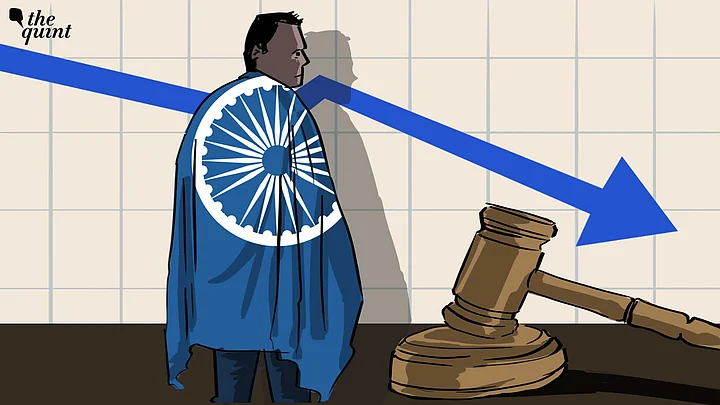
Cases of crimes against people belonging to communities in the Scheduled Castes (SC) and Scheduled Tribes (ST) categories have risen progressively and steadily between the years 2018 and 2022, according to figures by the National Crime Records Bureau.
These include crimes such as murder, assault on women, sexual harassment, stalking, kidnapping, and assault of children among others.
The NCRB — a government agency responsible for collecting and analysing crime data — released its latest report on 4 December.
An analysis of this data between 2018 and 2022 revealed that even as cases of atrocities against SC, ST communities went up, the conviction and charge-sheeting rates remained abysmally low.
This report, in 10 charts, looks at what the crime rate, charge-sheeting rate, and conviction rate across states tell us about atrocities against vulnerable caste demographics.
UP, MP, Rajasthan, Odisha Lead The Charts in 2022
As per the 2022 numbers, Uttar Pradesh (UP) with 15,368 cases recorded the highest total cases of atrocities against people from the SC category. Rajasthan with 8,752 cases stood second, whereas Madhya Pradesh (MP) with 7,733 cases was on number three.
It must, however, be noted that the crime rate (crime per lakh population) in Rajasthan was 71.6 — more than double that of UP which recorded a crime rate of 37.2. At the same time, Rajasthan's charge-sheeting rate was 45.9 percent, which means that a chargesheet was filed in only 45.9 percent of recorded cases. In UP, charge-sheeting rate stood at 84.9 percent.
A comparison of conviction rate also showed that while Rajasthan saw only 39.5 percent convictions, in UP, the rate was 80.2 percent.
MP recorded a high crime rate (68.2) and high charge-sheeting rate (99.5 percent) but the conviction rate remained low (22.9 percent).
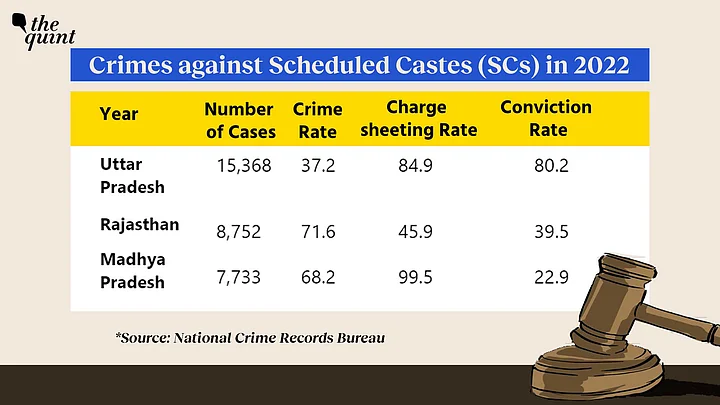
Most cases of atrocities against people belonging to the ST category were recorded in MP (2,979) followed by Rajasthan (2,521) and Odisha (773).
While MP and Odisha, 99.8 and 94.9 percent respectively, saw high charge-sheeting rates, Rajasthan's charge-sheeting rate remained low at 44.3 percent.
Again, conviction rates in MP and Rajasthan were 35.9 percent and 46 percent respectively while that in Odisha remained low at only 19.6 percent.
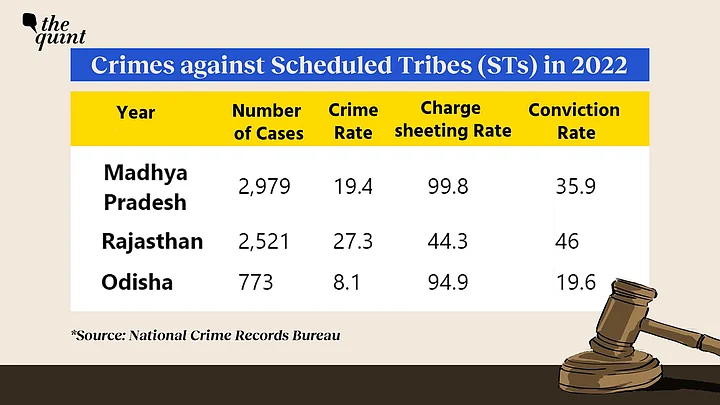
2018-2022: The Overall Figures
An analysis of NCRB data from 2018 to 2022 suggests that the conviction rates in crimes against people belonging to the SC and ST categories saw a spike in years before and after the Lok Sabha elections.
For instance, the conviction rate in crimes against SCs went up from 28.5 percent in 2018 to 32.1 percent in 2019 and 42.4 percent in 2020. The rate then dropped to 36 percent in 2021 and 34 percent in 2022.
This while the number of cases steadily increased from 42,793 cases in 2018 to 57,582 cases in 2022. The crime rate in this period also went up from 21.6 to 28.6.
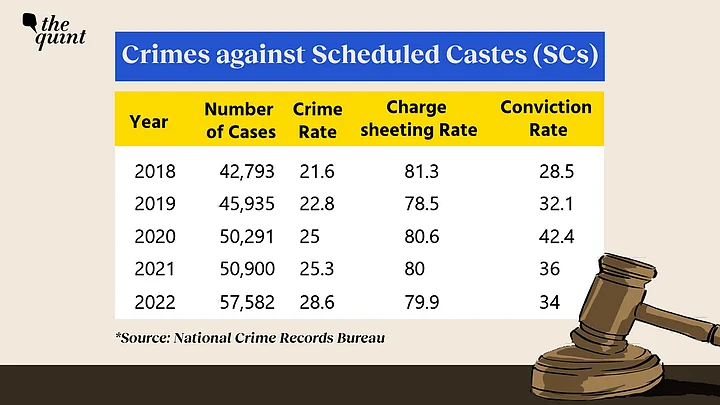
In cases related to atrocities against people belonging to the ST category, conviction rate went up from 23.5 percent in 2018 to 26.4 percent in 2019 and then went up to 28.5 percent in 2020.
It then plateaued at 28.1 percent while crime rate went up from 6.3 percent in 2018 to 8.4 percent in 2021 and 9.6 percent in 2022.
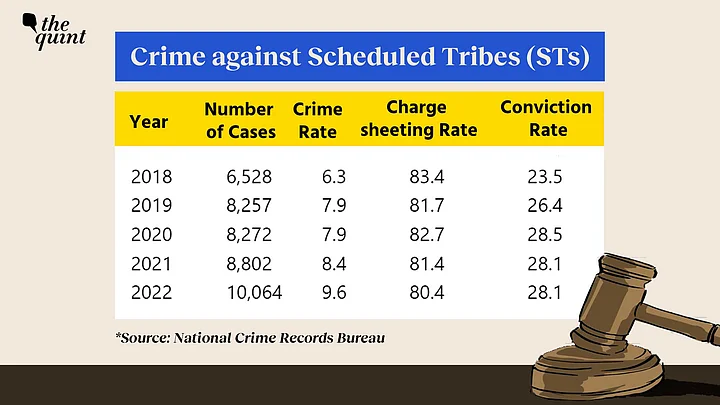
2018-2022: State-wise Data For Crime Against SCs
Over the last five years, UP, Rajasthan, and MP consistently recorded highest cases of atrocities against SCs. The crime rate in all the three states saw a steady increase.
In UP, it went up from 28.8 in 2018 to 37.2 in 2022. The conviction rate also increased steadily from 55 percent in 2018 to 80.2 percent in 2022.
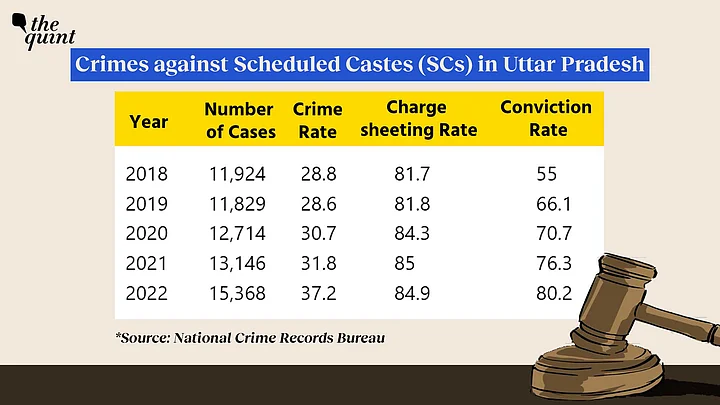
Rajasthan performed poorly in terms of charge-sheeting and conviction rates. While crime rate went up from 37.7 in 2018 to 71.6 in 2022, the conviction rate dropped from 43.6 percent in 2018 to 39.5 percent in 2022.
The conviction rate increased marginally in 2019 went up to 51.1 percent.
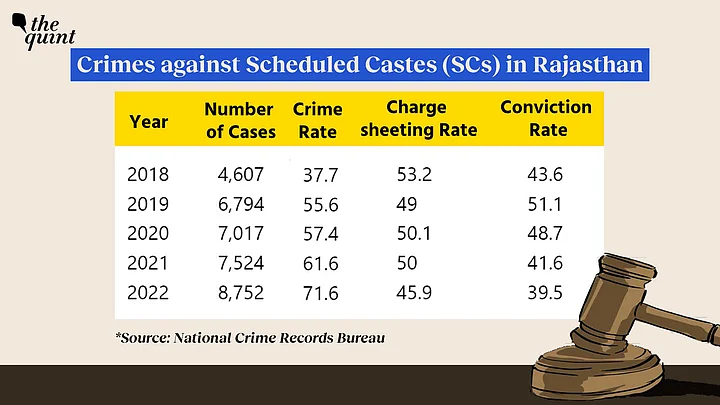
MP, also in line with trends seen in other states, saw a conviction in less than one-third of the charge-sheeted cases. While the crime rate went up from 41.9 in 2018 to 68.2 in 2022.
Despite a high charge-sheeting rate (above 99 percent in all five years), conviction remained abysmally low. It went up from 28.8 percent in 2018 to 31.5 percent in 2019 to 40.1 percent in 2020. Then, it dipped to 28 percent in 2021 and to 22.9 percent in 2022.
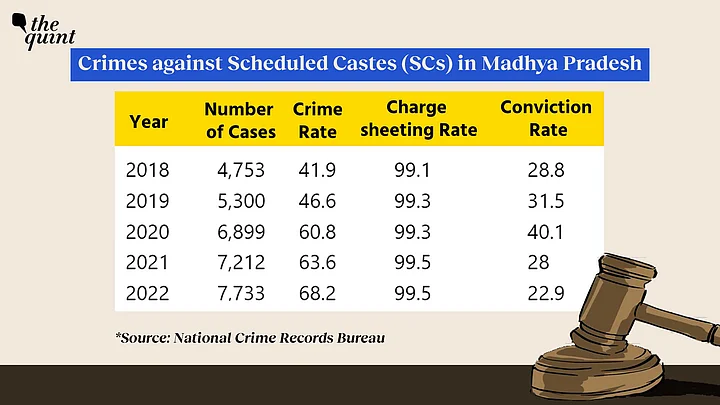
2018-2022: State-wise Data For Crimes Against STs
Madhya Pradesh, Rajasthan, and Odisha were the most unsafe states for people belonging to ST category as they recorded maximum cases of atrocities between 2018 and 2022.
In MP, the crime rate went up from 12.2 in 2018 to 19.4 in 2022. The conviction rate remained low fluctuating between 34 percent in 2018 and 35.9 percent in 2022. It marginally increased from 31.3 percent in 2019 to 35.9 percent in 2020.
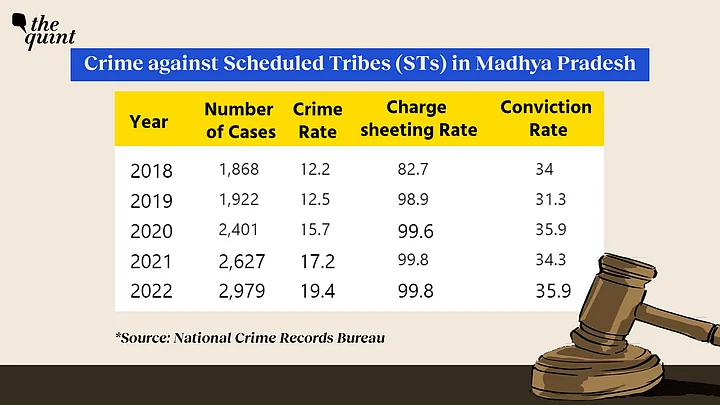
Rajasthan also saw a drastic rise in crime rate against STs as it spiked from 11.9 in 2018 to 27.3 in 2022. In the same period, the charge sheeting rate remained low with a charge-sheet being registered in only close to 50 percent cases. The conviction rate despite rising steadily, remained low.
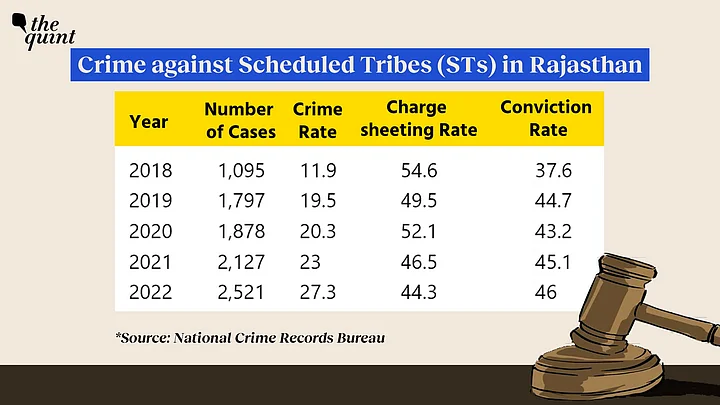
Odisha, which has a tribal population of close to 22.84 percent, saw a zero conviction rate in 2019, 2020, and 2021. While the crime rate went up from 5.8 in 2018 to 8.1 in 2022. The charge sheeting rate remained high with a chargesheet being registered in more than 90 percent cases.
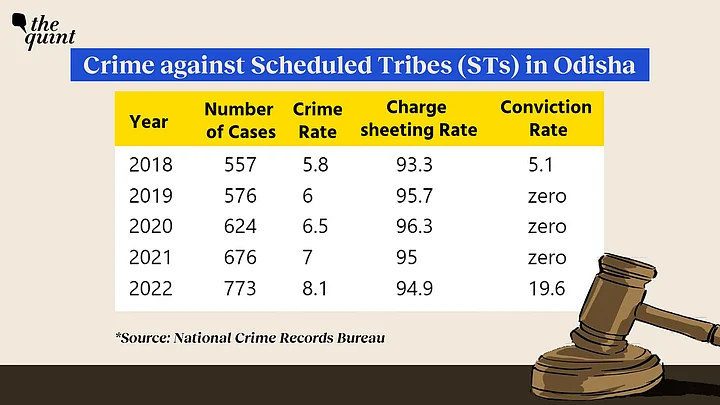
(At The Quint, we are answerable only to our audience. Play an active role in shaping our journalism by becoming a member. Because the truth is worth it.)
Read Latest News and Breaking News at The Quint, browse for more from News and Crime
BJP balances caste dynamics in MP, Rajasthan and Chhattisgarh CM picks
The party picked new faces in all three heartland states where it won earlier this year but was careful to cater to major caste groups by appointing deputy CMs

The party picked new faces in all three heartland states where it won impressive victories earlier this year but was careful to cater to major caste groups by appointing deputy chief ministers. This, analysts said, could help the party hold on to the rainbow Hindu coalition across castes that it built on its way to its second term in 2019.
The party’s impressive victories in these states had given way to frenzied speculation about the top jobs. This week, as the veil of suspense lifted from the BJP’s internal deliberations, it revealed a delicately crafted social engineering strategy that attempted to reach out to key communities – tribals, backwards, upper-castes and Dalits. This is a region where the party was already strong in 2019, having won 62 out of the 65 seats in the three provinces. But the renewed push could help the party beyond the heartland, and deepen its support base in these communities in next summer’s general elections.
Read
In Chhattisgarh, a state where the Congress squandered a landslide mandate from five years ago, the party picked a senior tribal leader, Vishnu Deo Sai, to be CM. Tribespeople had backed the party in large numbers – of the 29 reserved seats for Scheduled Tribes, the BJP won 17, up from the three it won in 2018. Tribals account for around a third of the state’s population, and Sai is from the Kanwar tribe, the second largest grouping after the Gonds.
“After the Congress pushed the OBC narrative, the BJP wants to ensure that the tribals know that they are a party that represents them with the Lok Sabha elections, and other state elections like Jharkhand in mind. This is the second biggest appointment after the nomination of Droupadi Murmu as President of India,” a senior BJP leader had said. The Lok Sabha has 47 seats reserved for Scheduled Tribes, a community that the party has aggressively courted over the past year, in much the same way it wooed Dalits ahead of the 2019 elections.
Two other deputy chief ministers are also likely to be named, said people aware of developments. One of them is likely to be senior leader and state unit chief Arun Sao, who hails from the dominant other backward classes (OBC) group, Sahus – a bellwether community that supported the Congress in 2018 only to swing back to the BJP this time.
The caste contours were equally visible in the party’s choices for Madhya Pradesh. Though it chose to replace four-time chief minister Shivraj Singh Chouhan, the BJP picked another prominent OBC leader, Mohan Yadav, as his replacement. With his appointment, the party ensured that its grip over OBCs – who not only form the largest chunk of the electorate in Madhya Pradesh but also the spine of the BJP’s national electoral coalition – remains
Further, by choosing a nominee from the Yadav community (which is dominant in Uttar Pradesh and Bihar but not to the same extent in Madhya Pradesh), the BJP opened the doors towards making inroads into the community in the neighbouring states.
Its choice of deputy CMs – Dalit face and senior minister Jagdish Devda and Brahmin face and outgoing public relations minister Rajendra Shukla – showed that the party was equally aware of its other key constituents. In its incumbency defying victory last week, the party won 26 of the 35 seats reserved for scheduled castes, up from 18 in 2018.
BJP spokesperson Rajneesh Agrawal said, “The decision of nominating chief minister and deputy chief ministers has been taken by considering many things like representation of region, ability to achieve goals, leadership quality, future aspects and others not only caste. It is wrong to say that the party gave preference to only one caste factor.”
And when the announcement in Rajasthan came on Tuesday, it closed the circle on its caste strategy by focussing on its strongest vote bank – upper castes. First-time lawmaker Bhajan Lal Sharma was named the CM. But the party, which seemed to move past two-time CM Vasundhara Raje, was conscious to nominate another member of the royal family, Diya Kumari, as deputy CM in an outreach to the dominant Rajput community. And, in a state where the party won 22 of the 34 seats reserved for scheduled castes, the other deputy CM came from the community, in the form of senior leader Prem Chand Bairwa.
Sivaji s.Dalit News 3.
School principal in TN booked for forcing Dalit student to pick stone from toilet

A case has been filed against the principal of a government school in Tamil Nadu’s Tirunelveli district for forcing an eight-year-old Dalit student to pick a stone out of a toilet on campus. The principal, identified as Ponrani from the Saiva Vellalar (Forward Caste) community, allegedly forced the child to pick a stone that had fallen into the toilet saying that “it was the kind of job the student’s community members did”.
The student is from the Arunthathiyar community, categorised as Scheduled Caste. Tirunelveli (Rural) Deputy Superintendent of Police (DSP) Anantha Raj M, who is investigating the case, said the incident happened on December 6.
The child complained to his parents and the mother filed a complaint against Ponrani on December 9, said DSP Anantha Raj. An FIR had been registered on the same day and that Section 31(r) of the Prevention of Atrocities Against Scheduled Castes/Scheduled Tribes Act and Section 75 of the Juvenile Justice Act have been evoked. However the principal is yet to be arrested and that preliminary investigations are ongoing, said the officer.
The case is the latest in the growing list of caste crimes in Tirunelveli district. Earlier in November, six men from the Maravar community (Other Backward Class) were arrested for assaulting, disrobing, and urinating on two Dalit youths near the Thamirabarani River. The Marvar men also robbed the Dalit youth of their cell phones and silver jewellery. In the same month, a 17-year-old was arrested for hurling country bombs at a computer centre in Nanguneri owned by Jaya TV journalist Vanamalai, who had extensively covered a caste crime that occurred in the area in October.
Read: Six arrested for disrobing, assaulting, urinating on Dalits in Tirunelveli
Before that, in October, a 17-year-old Nadar boy (Other Backward Class) stalked and killed an 18-year-old Dalit woman from the Devendra Kula Vellalar community in Tirunelveli town. Earlier in August, two Dalit siblings aged 17 and 14 were horrifically attacked with sickles in their own home by their own schoolmates from the Maravar caste.
In July this year, a 19-year-old Dalit youth was stabbed to death in Appuvilai village by a Nadar man in a suspected case of ‘honour’ killing.
In November, TNM travelled across Tirunelveli and neighbouring districts and found that from home to schools, children are deeply entrenched in caste supremacy. TNM found that the neighbouring Thoothukudi and Tenkasi districts, like Tirunelveli continue to be hotbeds for caste atrocities despite the ruling Dravida Munnetra Kazhagam (DMK)’s promises of social justice.
Sivaji s.dalit News 4.

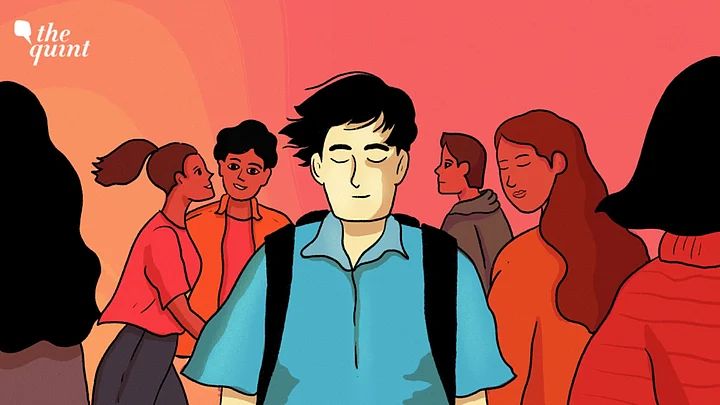
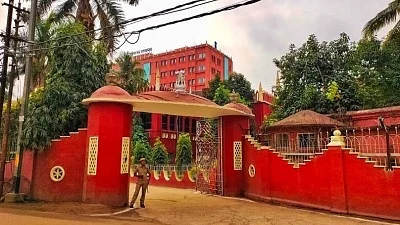

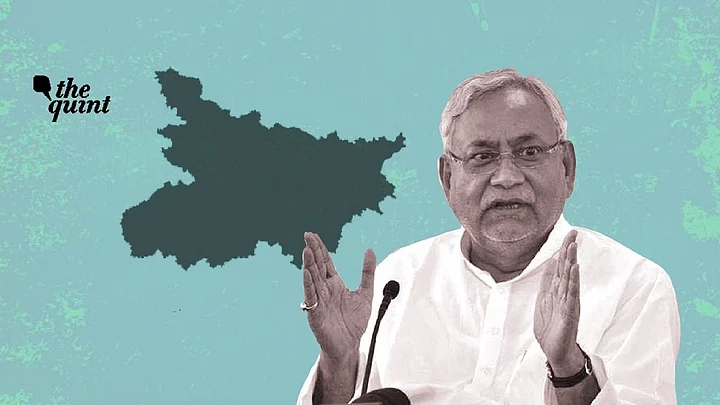






Comments
Post a Comment